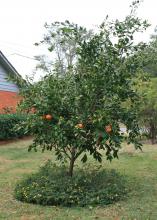Information Possibly Outdated
The information presented on this page was originally released on November 30, 2015. It may not be outdated, but please search our site for more current information. If you plan to quote or reference this information in a publication, please check with the Extension specialist or author before proceeding.
Mississippi temps allow citrus trees to succeed
Over the Thanksgiving holiday, I had the chance to get back into my garden and landscape after what seemed like a horticultural marathon that began in mid-July. While I hadn’t totally neglected my chores, there was still plenty to do.I harvested the remaining fall crop of heirloom tomatoes and removed the plants growing in my self-watering patio containers. I then proceeded to my citrus grove; understand that I use the term “grove” lightly, as it consists of two Satsuma oranges, two Meyer lemons and a kumquat. Despite being left to their own devices over most of the summer, I found ripe, gorgeous satsumas. Since they’re so easy to peel, resistance was futile, and I had to consume one of the oranges immediately.
Growing my own citrus is one of the best gardening endeavors ever. I started a couple of years ago after being inspired by my friend Terry, who can actually harvest over 1,000 Satsuma oranges from his two trees. His trees are obviously more mature than mine, and he has to use boards to prop up the heavily laden branches. Watch this Southern Gardening TV segment of our visit to Terry’s garden.
Satsuma oranges are really easy to grow, and if you don’t have a big yard, they grow and produce just fine in containers. They are also some of the most cold hardy of the citrus trees. In fact, my friend Ron Wilson, who has a national gardening radio show in Cincinnati, Ohio, enjoys homegrown, container-grown satsumas, which he easily moves into his greenhouse for the winter.
I also enjoy Meyer lemons, which are not like the tart, thick-skinned, grocery store offerings. They are a long-ago cross between a lemon and an orange and are thin-skinned and really sweet. Each year, my crop is destined for a batch of homemade limoncello, which is a family holiday treat.
Citrus trees need protection from cold weather, and I planted all mine in containers so I can move them to the garage. This precaution is important because citrus trees are grafted, and the graft union is susceptible to freeze damage.
Each year, I’ll get a question about a homeowner’s citrus tree having different fruit than the previous year. Generally what happened is the graft died for some reason -- usually freezing temperatures -- and the rootstock is now the dominant growth. A clue to this happening is the appearance of thorns on the branches.
I tend to go overboard when it comes to the garden, so I planted my citrus trees in 25-gallon containers. I quickly realized that there would be no way I was going to move these really heavy containers to the garage. I’ll have to resort to covering them when the temperatures dip.
Growing citrus is fairly easy in the coastal counties. Gardeners in Mississippi’s northern counties don’t need to be left out of the fun. Extension Publication 2542, “Growing Citrus in Containers in Mississippi,” is an excellent guide to success growing citrus in your garden or landscape.










